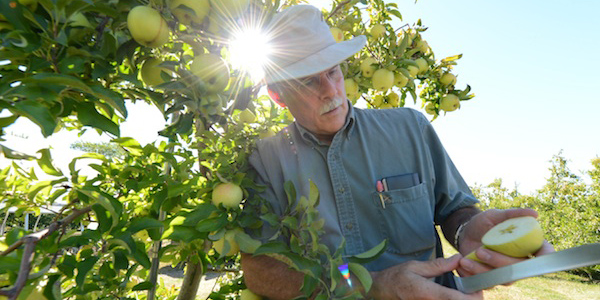
Innovative Research, Sweet Success
Orchard Advancements
Advances in integrated pest management developed at Iowa State stand to improve profitability for apple growers, food safety for consumers and potentially transform how diseases are managed industry-wide.
Mark Gleason, professor of plant pathology, and his colleagues are working to refine methods of spraying fungicides that fight major fungal diseases including sooty blotch and flyspeck and fruit rots. Their methods use weather and plant biology to pick the best time for application, rather than predetermined dates independent of orchard conditions. The new methods reduce input costs as well as the amount of residue present on the fruit at harvest, which improves safety and consumer confidence.
“If left untreated the black spots caused by sooty blotch and flyspeck make fresh market sale impossible. The fruit is then only fit for the cider market—a loss of 90% of value,” Gleason says. “ And, growers could save $75/acre if three sprays per season are eliminated. Best of all, growers value saving time, since they don’t have to apply so many sprays late at night when wind speeds are low.”
The researchers also are working to activate a regional warning system that will keep producers informed and ready to take action against the costly diseases.
Rhapsody In Blue (cheese)
Fred and Robert Maytag approached Experiment Station dairy microbiologists Clarence Lane and Bernard Hammer with a food challenge in 1937 that would transform cheesemaking.
Together they created the first American blue cheese using cow’s milk from the Maytag Dairy Farm, rather than the traditional sheep’s milk. The process is now known for producing the world’s finest blue cheese.
How Sweet It Is
Charlie Hall didn’t expect his seedless watermelon varieties would transform an entire industry. But, that’s exactly what happened.
Hall’s watermelons, bred for disease resistance and flavor, allowed his varieties to thrive in various soil types and conditions rather than a limited geographic area, which was the norm for variety development at the time.
“We went from a locally-based, seasonal watermelon industry to an international, year-round industry,” he says. “I had no idea that someday we’d be able to enjoy watermelon 12 months of the year. It’s a revolution compared to the 1950s.”
His sweet, seedless varieties remain the leading commercial varieties and serve as parents for many commercial hybrids around the world, both seeded and seedless.
Hall, who served as chair of the Department of Horticulture from 1974 to 1990, also worked with industry partners to begin to name fruit based on qualities rather than geographic area. As a result, the “Crimson Sweet” was born, and melons began to be marketed from produce stands across the country.
Good Eats
Eclectic Mix Of Iowa State Food Ends With Delicious Results
Lauren Grant, a CALS junior in culinary science, accepted a tough challenge— to create a unique recipe based on food developed in the College of Agriculture and Life Sciences. She came up with two tasty dishes using Crimson Sweet or All Sweet watermelon, Maytag Blue Cheese and Chieftain apples (a cross of Jonathan and Red Delicious developed at Iowa State): CALS Creamy Blue Fruit Dip and CALS Sweet Blue Melon Salad.



